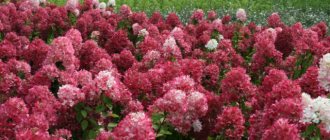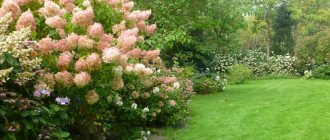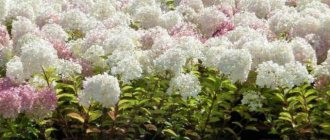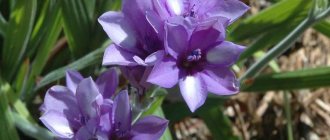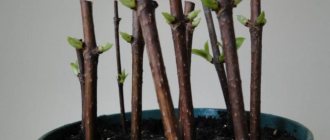Description
Gypsophila plant (lat. Gypsophila), or tumbleweed, rocking, gypsum - a herbaceous plant of the Clove family. Translated, the name of the plant means “lime-loving”, since many species of this plant grow in nature on limestone. Gypsophila flowers include more than one hundred species of shrubs, herbaceous annuals and perennials growing in Eurasia, Northeast Africa and New Zealand. Both annual and perennial gypsophila are grown in garden culture.
The root of gypsophila is powerful, taprooted and branched, the stem is almost leafless, prostrate or erect, reaches a height of 20 to 50 cm, but some subshrub species grow up to a meter or even higher. The leaves are small, entire, lanceolate, oval or spatulate. Loose paniculate inflorescences, simple or double, consist of small flowers of white or white with green color, although some species (creeping gypsophila or Pacific gypsophila) have pink flowers. The fruit is a single-locular polysperm, ovoid or spherical in shape. Gypsophila seeds remain viable for two or three years.
Description of the plant
Kachim (Gypsophila), known as gypsophila, is a species of plant (herb or shrub) belonging to the clove family, which includes about 150 species. Kachim is found in Southern Europe, Asia, North Africa, Australia, Oceania. In its natural state, gypsophila grows on dry hills and rocky areas. The name Gypsophila, translated from the Latin name, denotes the plant's love for gypsum soil.
Among gypsophila there are varieties that cover the soil, suitable for rockeries and cut flowers. A characteristic feature and main advantage of the plant is its countless small flowers. The plant bears small, five-petaled, cup-shaped flowers in varying shades of white, pink and light purple. The stems are strongly branched from below.
Underground, kachim forms a network of thickened roots up to 2.5 m long. The roots of the plant contain a lot of saponin and were previously used as a mild detergent, especially for wool. Gypsophila flowers have also been used for medicinal purposes (as an expectorant and diuretic).
In our climatic conditions, Kachim does not winter well, but special perennial varieties can be grown in greenhouses (for wedding bouquets) all year round.
Kinds
Gypsophila paniculata
- a perennial up to 120 cm high, quickly taking on the shape of a spherical bush. The stems are highly branched, pubescent narrow leaves are gray-green, flowers are no more than 6 mm in diameter, collected in paniculate inflorescences, simple or double, pink or white, depending on the variety. Varieties:
- – Bristol Fairy – white gypsophila, double, 60-75 cm in height;
- – Pink Star is also a double gypsophila, but with dark pink flowers;
- – Flamingo – double pink gypsophila 60-75 cm high.
Gypsophila elegans
- a spherical annual 40-50 cm high with highly branched stems, small lanceolate leaves and small flowers of white, pink or carmine color in openwork thyroid panicles. Blooms profusely, but does not last long. Varieties:
- – Rose – gypsophila with pink flowers;
- – Carmine – a variety with red flowers;
- – Double Star is a low-growing variety 15-20 cm in height with bright pink flowers.
Creeping gypsophila (Gypsophila muralis)
– branches
a pure annual with a bush height of about 30 cm. The leaves are linear, opposite, dark green in color, small pink or white flowers are collected in panicles. Varieties:
- – Fretensis – a variety with pink flowers;
- – Monstrosa – white gypsophila.
Pacific gypsophila (Gypsophila pacifica)
- a perennial spreading bush up to a meter high with highly branched stems, gray-blue wide lanceolate leaves and pale pink flowers 7 mm in diameter.
In addition to the listed well-known cultivated species, Gypsophila ypsophila yascoloid, areciformes, tender and Patrena's gypsophila are of interest.
Features of gypsophila
The strong taproot of this plant is branched. The erect or prostrate stem is practically leafless, its height varies from 20 to 50 centimeters. Subshrub species can grow up to 100 centimeters or even more. Small whole leaf blades have a lanceolate, spatulate or oval shape. The inflorescences are loose, paniculate in shape. They contain small greenish-white or white flowers, but in several species (for example, pacific or creeping gypsophila) they are pink in color. They can be simple or terry. The fruit is a single-locular achene, the shape of which can be spherical or ovoid. These seeds remain viable for 2–3 years.
Care and conditions of detention
Even a novice gardener can care for gypsophila. You will only have to water the plant during dry seasons, and the water should be poured at the root. Fertilizers should be applied, alternating organic with mineral ones, two to three times per season. For organic matter, use mullein infusion, but in no case fresh manure - gypsophila does not tolerate it.
How and when to collect gypsophila seeds.
In autumn, when the plant dries out, small boxes with gypsophila seeds, similar to brown grains of sand, appear in place of the flowers. The capsules are cut, dried in a room with good ventilation, opened and the seeds are poured onto newspaper or paper to dry and ripen, and when they are dry, they are placed in paper bags or cardboard boxes for storage.
Gypsophila in winter.
Perennial gypsophila is pruned at the end of autumn, leaving 3-4 strong stems at the root, then the remains of the bush are covered with dry leaves or spruce branches for the winter in case of a snowless winter or too severe frosts.
Growing from seeds
Let's get acquainted with all the nuances of growing gypsophila seeds.
When to sow
Typically, gypsophila seeds are planted for seedlings in the fall or spring. Autumn time is suitable for germinating seeds of annual varieties - they are directly planted in open ground.
Seeds are planted for seedlings in the spring: approximately April-May. The exact time depends on the climate of the particular area. Seedling cultivation is more suitable for perennial varieties.
The soil
In order for the seeds to germinate successfully and quickly, the soil in the container must be loose, well, but moderately moist, and permeable.
Sowing
- Make small grooves in the soil about half a centimeter deep.
- The seeds should be planted in the depressions and sprinkled with a little earth on top.
- Cover the top of the container with a transparent film and place it in a lighted and fairly warm place.
Watch a detailed video about sowing gypsophila seeds for seedlings.
Conditions for germination
Lighting and location
In order for gypsophila seeds to germinate successfully, the container with them must be in a bright place - a window sill on the south, south-west side is suitable.
Temperature
The seeds will sprout without problems if you keep them warm. If the external temperature is low, you can hardly expect good germination of seedlings.
Humidity, watering
Moisten the soil only as needed and only with a spray bottle. Remove condensation that accumulates on the back of the protective film in a timely manner.
With good proper care, seed sprouts appear within one to two weeks after sowing.
Reproduction
Sowing gypsophila seeds.
The gypsophila flower reproduces both by vegetative methods and by seeds. Annual gypsophila reproduces only by seeds, but there are also some perennial species that are grown from seeds. How to grow gypsophila from seeds? One-year-old gypsophila is sown before winter in open ground on a training (spreading) bed, and the following spring, the stronger seedlings are transplanted to a permanent place. Perennial gypsophila is grown in seedlings - the seeds are sown in early spring spaciously in seedling boxes to a depth of half a centimeter, the crops are covered with glass and placed in a bright, warm place.
Gypsophila seedlings.
When the seedlings appear after a week or two, they are thinned out so that the distance between the specimens is at least 15 cm, or they are planted one at a time in peat pots, and then gypsophila is grown with additional lighting, since seedlings require thirteen to fourteen hours of daylight for normal development, and in the middle of spring the days are still too short.
When to plant gypsophila.
When the seedlings have one or two true leaves, they are transplanted to a permanent place, and since perennial species can grow in one place for many years, planting perennial gypsophila requires a balanced approach to choosing a site. The best place for gypsophila is dry and sunny, with a low humus content and the presence of lime in the soil. If your garden soil does not contain lime or there is not enough lime, add 25-50 g of CaCo3 per m² of land so that the soil pH becomes 6.3-6.7. Do not plant gypsophila near groundwater - it does not like excessive moisture in the roots.
How to plant gypsophila.
If gypsophila is planted in two rows, then a gap of at least 0.7 m is maintained between the specimens, and 1.3 m between the rows. Make sure that the root collar does not end up underground when planting. The planted plants are watered. In two years, every second bush will have to be dug up so that there is only one bush per square meter. The root system of the dug up plants is cooled and transplanted to another location. This is done to increase the decorative value of gypsophila flowers, which are very good for cutting and as decoration in a composite bouquet.
Gypsophila blooms from seeds when the plant has formed at least 12 pairs of leaves, and the plant reaches its best shape three years after planting.
In addition to the seed method, gypsophila propagation is also used vegetatively - cuttings, especially when it comes to reproducing double plant varieties. Planting material is cut from young shoots before inflorescences begin to form - in May or late April, however, you can select young shoots and cut cuttings from them in August. The substrate for rooting needs to be loose, with the addition of some chalk. The cutting depth is 2 cm, the temperature for successful rooting is about 20 ºC. In addition, cuttings need twelve hours of daylight and one hundred percent air humidity, which is achieved by constructing a greenhouse. Rooted cuttings are planted in open ground with the expectation that they should have time to take root before autumn.
4. Planting and care
For planting, you should choose a place protected from strong gusts of wind. Gypsophila does not like direct sun during the daytime - for the flower it is worth choosing an area that is well lit in the morning, but in partial shade during the day.
When grown in heavy soil with a lot of melt or rainwater, the flower rots easily - plant it on a hill. Before planting, it is worth mixing a sufficiently large amount of sand or small stones into the soil to quickly remove excess moisture. It is very good to plant plants on the rocky slopes of alpine hills.
4.1.How and when to plant
Seedlings are planted in open ground in May, when night frosts have passed. A garden plot with loose soil that easily allows moisture and air to pass through is first prepared for planting.
They dig up the ground and select weeds with roots, add sand and crushed chalk. Prepare planting holes, the distance between which should be approximately equal to the height of adult plants, but not less than 40 - 50 cm. For tall flowers - for example, gypsophila paniculata - leave 90 - 120 cm between the holes.
The depth and width of the holes should exceed the root ball by several centimeters. Before planting, it is worth making a drainage layer in the form of river sand 2-3 cm high at the bottom of the holes.
If the seedlings were grown in plastic containers, then a day before planting, they are watered abundantly to soften the earthen clod. If the flowers were grown in peat pots, then they are planted with them.
The planting depth must be maintained - the bushes are positioned so that the root collar is flush with the soil surface. After planting, the soil around the plants is lightly compacted and the gypsophila is watered.
To prevent rapid evaporation of moisture, the base of the plant is mulched with clipped grass or straw, sawdust or pieces of pine bark. The mulch layer can reach 4–5 cm in height.
As the tall species grows, it is provided with support. Since with age the plants will take on impressive sizes, they are planted out or the excess bushes are simply pulled out, leaving only 1 plant per square meter.
4.2.Soil
Gypsophila prefers very loose soils that easily allow moisture and air to pass through, with a high content of river sand. They easily tolerate substrates that are quite poor in nutrients. Plants do not like acidic soils, preferring alkaline or neutral soils with a pH level of 6.5 to 7.5.
The flower reacts positively to the presence of lime in the soil - before planting in the soil, you should mix crushed chalk, slaked lime and add wood ash as an additional fertilizer. The name “gypsophila” itself means that the flower grows in the ground from gypsum.
4.3.Water and fertilize
Plants do not require abundant and frequent watering - watering is carried out only if the weather has been dry and warm for a long time. Mature plants easily tolerate drought and do not tolerate flooding. Only planted young bushes will need regular watering. Water the flower in the morning or evening with warm water, from a watering can with a long spout, at the root.
You should not water during the daytime - the moisture may evaporate without having time to be absorbed into the ground. Up to 5 liters of moisture are added to each specimen. After watering, the soil surface is loosened and the area is weeded.
Gypsophila does not like large amounts of nutrients in the soil - it blooms less profusely and forms a large number of leaves. Such plants are easily susceptible to fungal diseases. During the first summer, perennial plants do not need to be fed at all.
Only when growing in very poor soil can you apply mineral fertilizers in very low concentrations 2-3 times per season. The flower reacts positively to the use of well-rotted organic matter - humus, manure.
4.4.Transplant
In the same place, gypsum can grow for 20 years or more, forming a lush and abundantly flowering bush with age. Perennial species often have a negative attitude towards transplantation - it is better to immediately choose a permanent location for gypsophila. The fact is that the plants have a fairly large bark system, which is easily damaged during transplantation, after which the bushes begin to hurt for a long time.
If absolutely necessary, carry out transshipment - move the flower to a new place along with the old lump of earth, trying not to destroy it. For transshipment, planting holes are prepared nearby, the depth and height of which will slightly exceed the size of the earthen ball. A piece of polyethylene is spread next to the plants.
The flower is dug up, taken out of the ground and placed on plastic film, on which it is transferred to a new place. Plants are planted so that they remain at the same depth as before. After planting, the bushes are watered abundantly and protected from direct sun for 5 - 6 days.
If possible, it is better to postpone transshipment until the onset of cloudy weather. You should not replant plants with buds and flowers - it is better to replant in the spring, before the flowers form or in early autumn, so that the bushes have time to build up the root system and adapt to the new place before the onset of cold weather.
4.5. Shelter for the winter
Many plants do not tolerate frost and are grown as annuals. When grown in the conditions of the Middle Zone, they cover mainly young plants planted this year. In more northern regions, it is worth covering even adult specimens.
In order to help perennial gypsophila survive the frosty months, it is worth organizing a shelter. In mid-autumn, when the temperature at night begins to drop below zero, almost all shoots are cut almost to the ground and the bushes are sprinkled with a high layer of mulch. On mature bushes, only 3 to 4 of the strongest shoots are left.
At this time, you can use sawdust or dry fallen leaves as mulch. You can also additionally insulate the plants using spruce or pine spruce branches and cover them with the first snow that falls. Remove the cover in the spring, when the snow cover melts.
4.6.How to prune gypsophila
After the buds begin to fade, the flower stalks are cut off almost at the very base. Pruning is carried out with a sharpened sterile instrument - a garden knife or pruning shears. When used for cutting, shoots are cut when only less than half of the buds have opened - the rest will bloom in a vase with water.
Transfer
It is recommended to replant Gypsophila if it grows in your room once a year in the spring. When replanting, you should select a pot that is suitable in size. If the plant grows in your garden, then replanting is not recommended, since Gypsophila has a very long root and replanting can harm it. Immediately after the plant has been transplanted, it needs to be watered abundantly and it is advisable to provide it with partial shade. In order for the plant to take root well, additional air humidity is provided. After rooting, humidity is reduced and the plant is provided with adequate lighting.
How to care
Let's find out what kind of care gypsophila requires when growing it in a flower bed in the garden.
Watering
The soil in the flower bed with this plant should be moistened moderately, avoiding stagnation of moisture. Gypsophila does not tolerate waterlogging with difficulty, especially systematically. After watering on the second day, it is recommended to loosen the soil.
Tip: when watering, direct the stream of water strictly under the root so that the leaves and buds of the plant do not get wet.
Top dressing
In order for gypsophila to grow well and enjoy long-term flowering, it needs fertilizing. Fertilizers must be applied once a month during the growing season, using minerals and organic matter alternately. It is better to take complex mineral fertilizers, which contain all the microelements necessary for plants.
Among organic fertilizers, it is optimal to use mullein infusion. Do not use fresh manure: applying this fertilizer can even destroy the plant.
Trimming
The procedure is carried out when preparing gypsophila for winter: it is clear that it is not needed for annual plants.
Pre-winter pruning involves removing the entire vegetative part: only stumps 5 cm high remain above the ground. Pruning is done only after the plant has completely dried out on its own. And in order for young gypsophila to overwinter better, it is recommended to cover it with a layer of fallen leaves on top for the first time.
Collecting seeds
If you want to have your own gypsophila planting material, adapted to the conditions of your site, do not forget to collect the seeds on time.
Harvesting is done in the fall, but only after the plant has completely dried and the capsule has matured. Remove the bolls from the bush, dry them indoors, then remove the seeds. Once the seeds are outside, dry them again by scattering them on paper. The bag of seeds should be stored in a paper or fabric bag in a dry place.
Diseases and pests
With insufficient care, gypsophila can be affected by gray rot and rust.
, as well as
root-knot or cyst nematodes
. Nematodes are fought by repeatedly spraying plants with phosphamide with an interval of 3-5 days between sessions, but if this does not help, you will have to dig up the bush and wash its roots in hot water at 50-55 ºC, since the nematode dies at a temperature of 40 ºC. For rust and gray rot, spray gypsophila with contact fungicides - Bordeaux mixture, oxychome or copper sulfate.
Snezhinka: variety description, care
Planting the perennial gypsophila Snowflake, the photo of which is presented just above, caring for it is not much more difficult than the previous option, but you still have to familiarize yourself with the basic theoretical information so as not to ruin the crop with excessive watering or the scorching sun. This variety has fairly spreading bushes that reach half a meter in height. The flowering period is characterized by the entire plant being covered with small double white flowers, which are very similar in shape to snowflakes. This is a fairly light-loving and drought-resistant variety that grows quietly both in light and in partial shade. The plant also looks great in combination with other brightly flowering crops and various decorative flowers.
Type Characteristics
The plant has up to 150 varieties. Of these, about 40 are used for landscape design. The annual types of this representative of the flora are as follows:
- Gypsophila is graceful - with its branched shoots it forms an almost perfect ball. The height of the bush reaches 0.5 m. It has small leaves, painted in gray and green tones. The panicles contain white flowers. Varieties Rose and Carmine.
- Creeping gypsophila looks like grass. Its height is no more than 0.3 m. It is divided into 3 varieties: Monstrosa with white flowers, Frantensis and Haze - with pink, ruddy inflorescences.
Creeping gypsophila in a pot
Perennial crop types:
- Gypsophila paniculata forms a bush in the form of a ball. Its height is about 1.2 m. Varieties: Pink Star, Flamingo, Bristol Fairy, Snowflake.
- The bush creeping along the ground has Gypsophila yaspoliformes. Its height reaches 90-100 mm. It is covered with white or purple flowers.
Gypsophila perennial
Plant care
Gypsophila is a perennial plant that is not particularly demanding of care, but to obtain a lush, densely flowering plant, you must adhere to a number of rules when planting and growing. In the fall, when preparing gypsophila for winter, the above-ground part is cut off and sprinkled with fallen leaves and straw. This is especially necessary for young plants.
Caring for gypsophila consists of periodic fertilization, loosening the soil, removing weeds, and moderate watering.
Planting and caring for perennials in open ground requires a bright sunny area, dry, loose sandy, drained soil with the addition of limestone. Gypsophila flowers are able to retain their appearance even when dried, and therefore they are actively used in various floral arrangements, both with fresh and dried flowers.
The soil
For better development of herbaceous plants in open ground, the soil chosen is dry sandy-clayey, limestone, loose, well-drained, and fertilized. In general, the plant can be grown in any soil, provided that a small amount of lime is added to the soil to create an alkaline environment.
Top dressing
For better growth and abundant, long-lasting flowering, complex mineral and organic fertilizers are applied alternately once a month.
Experienced flower growers advise feeding the bushes with mullein infusion, which will sufficiently enrich the gypsum plant with all the necessary nutrients. It is extremely dangerous to use fresh manure as a top dressing; it can greatly harm the flower and even lead to death.
Features of care
There are no specific requirements for the growing conditions of gypsophila, planting and care. However, certain recommendations will still have to be followed if you want to enjoy the lush blooming and luxurious appearance of the flower.
- Priming. First, the landing site. It should be well lit, as the plant loves to bathe in sunlight. Secondly, the soil. Loamy soil is best. It is desirable that it allows air to pass through well and contains a little lime. Gardeners are advised to make reliable supports to support the bushes.
Where groundwater comes too close, it makes no sense to plant bushes.
- Feeding. When the area is well lit, the gypsophila plant develops well. Therefore, it is not necessary to apply fertilizers. Otherwise, you can’t do without minerals and humus. Make sure that the preparations used do not change the acidity of the soil. Mullein tincture has proven itself quite well. But with fresh manure you need to be careful. It can damage the bush. Fertilizing is applied in the spring.
- Watering, irrigation. It tolerates drought well, so when grown in open ground it does not require abundant watering. But if the air temperature stays at +30 degrees or higher for several weeks, and there is no precipitation, it is recommended to pour 3-5 liters of water under the root.
- Preparing for winter. Almost all varieties are frost resistant. However, it is still recommended to make additional insulation. In October-November, the stems are pruned, leaving 10 cm. The soil is mulched with peat, and dry leaves are poured on top and covered with pine branches. It is important that the root system does not come into contact with snow.
- Reproduction. This issue will be discussed in a separate part of the article. Let us only note that for annual gypsophila, growing from seeds is relevant. Perennial species are recommended to be propagated by seedlings. The grains are sown in boxes and placed to a depth of 5 centimeters. Covered with film, they will germinate much faster. The boxes are cut slightly greenish and dried at home. Store in paper bags.
Feeding for gypsophila
Principles and methods of reproduction
A gardener can independently determine how to grow a plant in the garden. The effectiveness of these methods varies, and the flowering process also differs.

